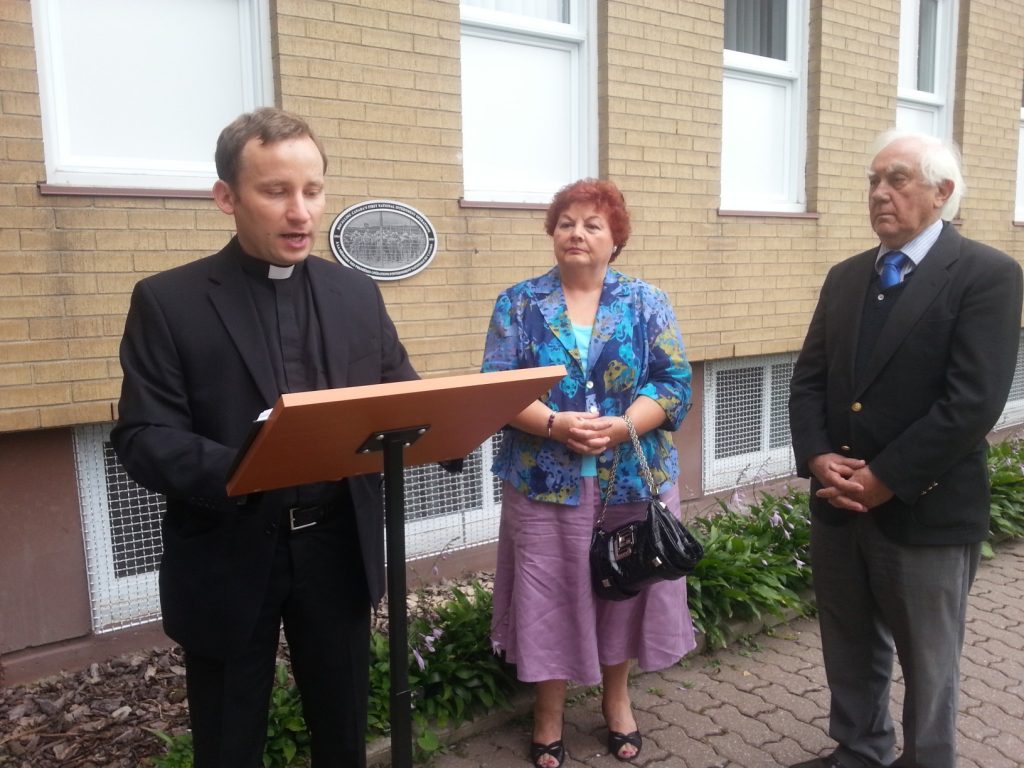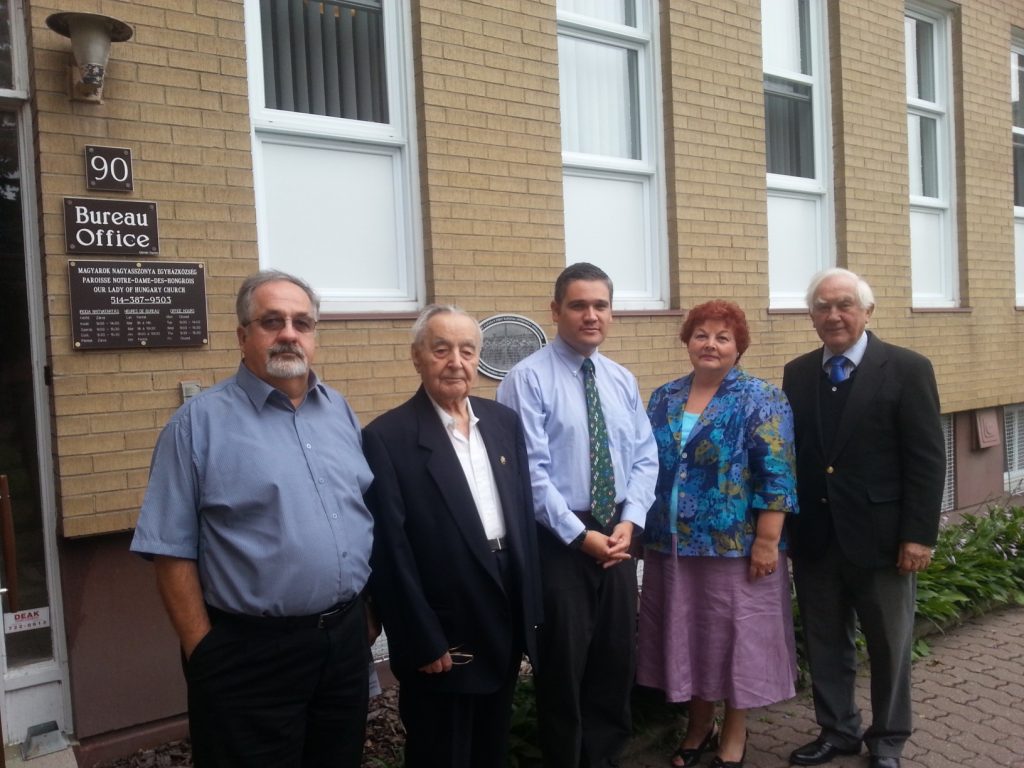August 22nd 2014
By Christopher Adam
On August 22nd, 2014, one hundred plaques commemorating the one hundredth anniversary of the internment of Eastern Europeans by Canadian authorities between 1914 and 1920 were unveiled in communities across the country. Our Lady of Hungary Parish in Montreal unveiled one such plaque, remembering the victims of wartime xenophobia, some of whom were of Hungarian origin.

Among those present were Fr. Szabolcs Licskó, pastor at Our Lady of Hungary Parish, Gyula Szentmihályi, Hungary’s honorary consul in Montreal, Tibor Kelemen, chair of the Hungarian Committee of Montreal, Júlia Ciamarra, Parish Council chair and historian Christopher Adam, an adviser for the Canadian First World War Internment Recognition Fund and member of its Endowment Council between 2008 and 2012.

From left to right: Fr. Szabolcs Licskó, Júlia Ciamarra, Gyula Szentmihályi
Fr. Licskó read from Psalm 37 during the ceremony and spoke to the fact that in spite of the oppression and exclusion experienced by interned Europeans (including Hungarians), the victims, descendants and future generations of immigrants continued to be instrumental in building the tolerant, diverse Canadian society in which we live today.
Prime Minister Stephen Harper also issued a statement on the occasion of the 100 commemorations across the country and in remembrance of the Ukrainians and other Eastern Europeans interned.
“Many of the internees came to our shores seeking to escape oppression and to build a better future for their families, but instead found themselves imprisoned simply for having come from territory controlled by the then-German or Austro-Hungarian empires. This practice persisted even after the British government advised that most of these so-called ‘enemy aliens’ were in fact sympathetic to our war aims and encouraged Canada not to intern them. Governments have a solemn duty to defend against legitimate threats in wartime, but we look back with deep regret on an unjust policy that was implemented indiscriminately as a form of collective punishment and in violation of fundamental principles of natural justice, including the presumption of innocence”–noted Mr. Harper.
“Today, the descendants of internees of Ukrainian, Croatian, German, Hungarian, Polish, and other ethnic origins, will be gathering in churches and community centres across the country to pray and to reflect on this sad moment in our history. I encourage all Canadians to take part in these events”–added Prime Minister Harper.
More than 8,600 innocent men, women and children of Eastern European descent were interned in 24 camps across Canada between 1914 and 1920 as enemy aliens and often had to engage in forced labour. A total of 109 died or were killed in the camps and in addition to the thousands interned, over 80,000 were required to register with authorities in their respective home towns as “enemy aliens.” Most were originally from the lands of the Austro-Hungarian Empire and the single largest national group to be interned were the Ukrainians. As such, in 1994 — at a time when the Government of Canada had yet to recognize this dark chapter in the country’s history and when surviving internees had few people who were willing to listen to their harrowing experiences — the Ukrainian Canadian Civil Liberties Association began placing commemorative plaques and markers at the 24 internment camp sites.
By the time the federal government moved to acknowledge the injustice that thousands of Eastern Europeans had suffered during and immediately after World War I, only two former internees – Mary Manko Haskett and Mary Hancharuk- were believed to be still alive. In November 2005, after decades of denial and silence, the Senate passed Bill C-331, entitled the ‘Internment of Persons of Ukrainian Origin Recognition Act.’ In 2008, the Government of Canada established a $10 million endowment (later named the Canadian First World War Internment Recognition Fund) to recognize, research and commemorate Canada’s first national internment operations, to which thousands of Europeans of many linguistic, national and religious backgrounds fell victim.
The Canada Hungary Educational Foundation was part of this narrative of historical recognition, remembrance and justice, with Christopher Adam, one of the Foundation’s board members, serving on the Endowment Council for nearly four years. During this formative time in the Fund’s history, an interpetation centre was establish in Spirit Lake, Québec (on the site of a former internment camp), as well as in Banff National Park and an internee cemetery in Kapuskasing, Ontario, was reconsecrated.
While it took over eight decades for this historical injustice to make its way into Canadian history textbooks and for memorials to mark the sites of previous internment camps and cemeteries, today’s students of history have a growing body of primary and secondary sources, as well as examples of public history, with which to work when exploring this often forgotten and neglected chapter in the country’s World War I history. There is perhaps no better time to begin this exploration than during the one hundredth anniversary commemorations of the War.

From left to right: Tibor Kelemen, Charles Baka, Christopher Adam, Julia Ciamarra, Gyula Szentmihályi
